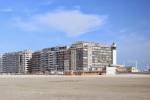Blankenberge Lighthouse


The Blankenberge Lighthouse, also known as Comte Jean Jetty, stands as a historical monument on the Flemish coast, narrating the story of navigation, war, and maritime advancement.
What can you expect at the Blankenberge Lighthouse?
- Historical Value: The Blankenberge Lighthouse is an icon of maritime history, dating back to the Middle Ages, with its first mention in 1337.
- Architectural Evolution: The current concrete lighthouse, completed between 1950 and 1954, showcases the architectural style of the interbellum and replaces the previous structures that had their own stories and tragedies.
- Automation: Once the home of the lighthouse keeper and his family, the lighthouse is now fully automated and no longer inhabited.
- Not Accessible to the Public: Although the lighthouse itself is not open to visitors and cannot be climbed, it serves as a picturesque landmark and a reminder of the rich maritime history of Blankenberge.
The Blankenberge Lighthouse offers a unique insight into the history of maritime navigation and defense along the Belgian coast.
Features
- Name: Blankenberge or Comte Jean Jetty
- Year of Construction: 1954
- Tower Height: 32.5 m
- Light Height (above sea level): 33.9 m
- Steps: 121
- Manned: No
- Accessible to the Public: No
Practical Information
- Location: Situated to the east of the harbour entrance, the Blankenberge Lighthouse is a prominent feature of the Belgian port city.
- Visit: Although the lighthouse is not open to the public, the area around the lighthouse offers beautiful views and photo opportunities, especially at sunset or sunrise.
The Blankenberge Lighthouse, with its rich history and characteristic appearance, remains an important symbol of the city and a must-see for anyone visiting the Belgian coast.
Furthermore Blankenberge Lighthouse is near the following sights: VVW Blankenberge Marina (±225 m), Kids Karting Leopoldpark (±550 m), Recreation Park Leopoldpark (±550 m), Sportland (±850 m) & Black Light Mini Golf (±900 m).